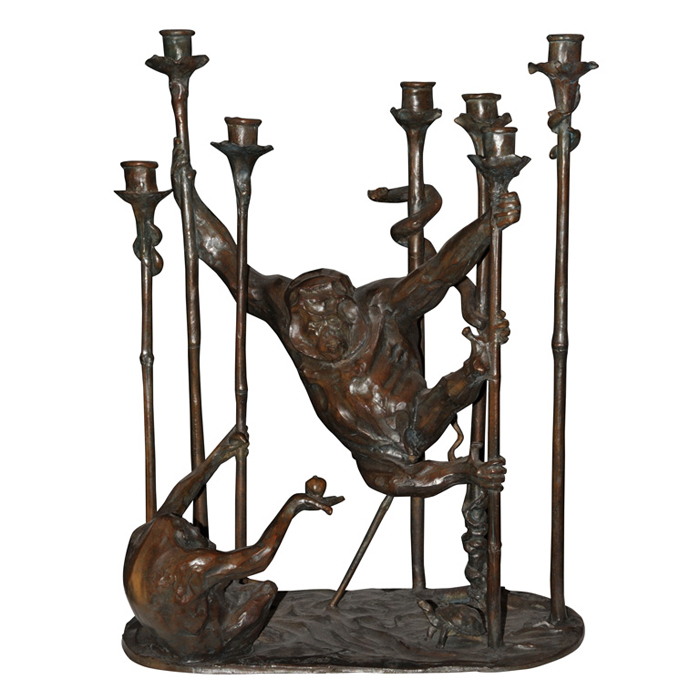Hadrien David is a philosopher by education. Therefore, for him, an animal form is just a pretext for a movement belied by the form. Sometimes his exploration gets through to us as an animal, and on other occasions it manifests itself as some other form of life. His concept of nature is lively and dynamic.
As he investigates the primitive aspect of our nature, the sculptor arrives at the pristine aspect of an animal, which is its sacred manifestation. This “sacredness” of an animal, usually worshiped and glorified from the dawn of mankind, is brought to the forefront again here. The sculptor builds his own private temple for the animals, the way monkey temples were built in India, or jaguar sanctuaries were created in Mexico.
The big animals retain their most static, archaic dimension. Beasts such as elephants, hippopotami, or gorillas are sacred “prophets” in the sculptor’s personal symbolic language. He gives a perpetual moving energy to their mass as exemplified in the voluminous sculptures of the beasts David chooses to create. The sculptor freezes the beasts in an instant in which the animal’s energy manifests itself. As the result, the sculpture’s power is embodied in that reduced and minimized momentum. The sculptor formally divides his work into three categories of sacred priests, warriors, and terrestrial beings.
However, his bronzes, taking forms such as Darwin or a Zoroastrian prophet, deny all the categories: ontologically they nourish the idea of the embryo and its metamorphosis. The sculpture tells us the story about our birth and development on earth where the fallen Adams and Eves give in to earthly pleasures.
The series of “Prophets” includes mythical beings—an orangutan who is a Pharaoh, an Asian elephant who is mightier than Ganesh, an African marabou invoking prophecies, a study of a hand escaped from Michelangelo’s studio, and a fortune-telling mouse. Even the prince of darkness Satan himself appears in a sculpture entitled Batman, and again in Dark Prince, which is a graceful bronze of a scorpion. However, all of these “ animals,” being already pure in their essence, do not evoke the Aristotelian notion of catharsis.
The binding element in all of them is humor, which ranges from Daumier’s grotesque, with the Pharaoh, to the Surrealist joke, as exemplified in the insects and smaller animals in Hadrien’s theater of “earthly delights.”
Many of these sculptures openly originate from images drawn from Biblical tales. The animals are really princely creatures for him, thus the story of the Dark Prince or the story of a fallen angel who dabbles with religions and terrorist actions, and who is our “next-door neighbor” out there to kill or undermine our desires.
In contrast to these concrete figures from the animal and the animated world, there stands a long 2.4 meter totem made in mortar, which serves as an abstract “animus” for the sculptor, representing his interior as a process of constant transformation. During the years of the demanding work with bronze as material, Hadrien David has acquired and developed his own themes—from Michelangelo he takes a muscular precision mixed with a lyrical beauty, which is the manner in which he works on his torsos. Gericault had inspired his approach to horses, and Degas’ dancers and choreography informed his approach to smaller animals.
A cinema-inspired approach is also very characteristic of the sculptor’s work. The group of “Warriors” consists of powerful animals; white leopards, bulls, running horses, jaguars, and apes. Here, the warrior’s stance is manifested in an upward movement through the air. These beasts are never quite static as they embody the essence of the movement itself. This exceptional quality in David’s work makes a clear distinction between his sculptures from a great number of artists who have worked within the same genre.
There is an erotic force in his forms, as their muscular mass takes over the space they inhabit. On view here is a certain Husserlian notion of epoche, a sort of suspending of the “natural attitude” toward the object that we experience. In order to get us into this state of suspension that we have in relation to an animal, the sculptor does an in-depth “dissection” of the model. This approach was observed by the old masters, but it has all but completely disappeared over time. He is influenced by the Classical Greek art and their approach to sculpture. The frog is, perhaps for him, the animal that expresses the plasticity of the body most dynamically.
Hadrien David’s harmonic vision is at its best in his “terrestrial” group, obeying the perpetual rites of fecundity including gorillas (Adam’s Temptation), dancing frogs (The Egyptian), and kangaroos (The Athlete). As all these animals belong to the same earthly parade, the sculptor places them in an unusual setting within his work The Doors of Paradise. It is here that his work resembles more the work of a theater director who places the scenes into a certain sculptural setting. Here he approaches both the Surrealist cinema of Jan Svankmajer or Antonin Artaud’s theater of cruelty.
Hadrien’s sculptures, thus, are both real and surreal. Their reality comes from the feeling that sculpture is the stomach of our history, and as the history of sculpture is his life-story, it is also the story of his multilayered presentation of the past combined with the present.
By Nina Zivancevic
























